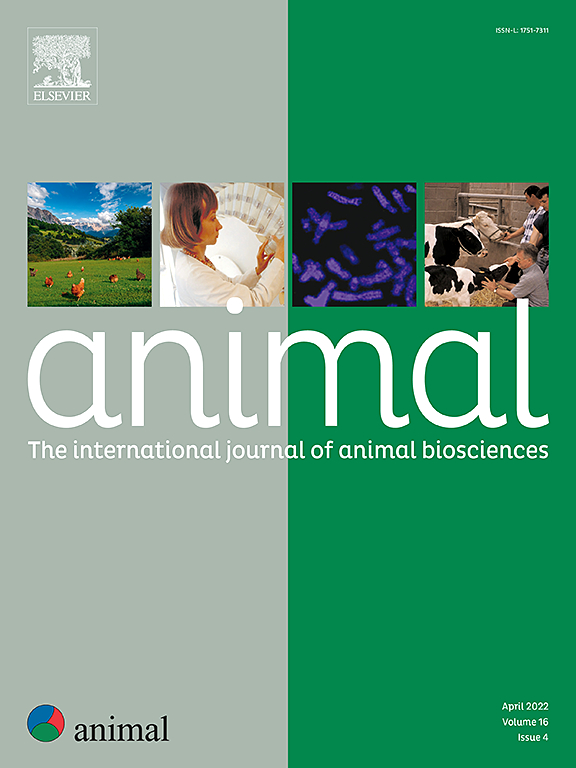Influences on calf productivity during five decades of cow-calf grazing of northern prairie
IF 4.2
2区 农林科学
Q1 AGRICULTURE, DAIRY & ANIMAL SCIENCE
引用次数: 0
Abstract
Understanding calf weight gains from grazing rangeland ecosystems requires long-term data to disentangle influences of biophysical and animal factors, and management. However, long-term experiments with consistent management treatments with livestock weight gain data are scarce. To address this gap, we analyzed a legacy dataset of grazing during the growing season (June-September) in native northern mixed-grass prairie of the North American Great Plains that included individual on– and off-pasture weights of Hereford (1975–2001) and crossbreed (2003–2021) cows and calves grazing from June to September, spanning 47 years near Cheyenne, Wyoming. We used regression tree analyses to evaluate the influences of biophysical (forage production estimated via NDVI LANDSAT time series, temperature, and precipitation) and individual animal factors (breed (Hereford from 1975 to 2001 and crossbred from 2003 to 2021), cow age, cow BW, and calf gender), and management (stocking rate, Animal Unit Days per hectare), on individual calf weight gain. We observed a positive temperature trend and a negative precipitation trend over the five decades. Forage production was positively associated with precipitation and negatively with temperature. Breed (Hereford vs crossbred) was the most important factor for calf weight gain, followed by stocking rate, temperature, cow weight, precipitation, cow age, forage production and calf gender, with the fitted model explaining 64% of the variation in calf weight gain. Calves from crossbred cows gained 26% more than calves from Hereford cows (1.2 vs 0.88 kg/head per day). Our findings from nearly five decades of grazing research offer key insights for beef production responses from native, northern mixed-grass prairie rangeland ecosystems. First, crossbreeding offers advantages to calf weight gain. Second, the importance of stocking rate and cow BW on calf weight gain, along with observed trends of precipitation and temperature influencing forage production, underscores the need for more flexible management for sustainable beef production. Third, over the five decades of this experiment, factors influencing individual productivity have shifted from variables associated with the selection of the animal biotype and stocking rate to primarily climatic factors. The shift from management-driven factors to more variable climate-driven influences reflects the need for adaptive grazing management —a structured approach that involves planning, monitoring, and adjusting strategies in response to environmental variability.
北方大草原50年放牧对小牛生产力的影响
了解放牧牧场生态系统对小牛体重增加的影响需要长期数据,以理清生物物理和动物因素以及管理的影响。然而,与牲畜增重数据一致的管理处理的长期实验很少。为了解决这一差距,我们分析了北美大平原北部原生混合草草原生长季节(6月至9月)放牧的遗留数据集,其中包括6月至9月放牧的赫里福德(1975-2001)和杂交(2003-2021)牛和小牛的个体牧场内外体重,跨越47年,位于怀俄明州夏延附近。我们使用回归树分析来评估生物物理(通过NDVI LANDSAT时间序列、温度和降水估算的饲料产量)、个体动物因素(品种(1975年至2001年的赫里福德和2003年至2021年的杂交)、奶牛年龄、奶牛体重和小牛性别)和管理(放养率、每公顷动物单位天数)对个体小牛增重的影响。50年来,气温呈正趋势,降水呈负趋势。饲料产量与降水量呈正相关,与气温负相关。品种(赫里福德vs杂交)是影响犊牛增重的最重要因素,其次是放养率、温度、奶牛体重、降水量、奶牛年龄、饲料产量和犊牛性别,拟合模型解释了犊牛增重变化的64%。杂交奶牛的犊牛比赫里福德奶牛的犊牛增重26% (1.2 vs 0.88 kg/头/天)。我们近50年的放牧研究结果为本地北部混草草原牧场生态系统的牛肉生产反应提供了关键见解。首先,杂交有利于犊牛增重。其次,放养率和奶牛体重对犊牛增重的重要性,以及观测到的影响饲料生产的降水和温度趋势,强调了对可持续牛肉生产进行更灵活管理的必要性。第三,在50年的实验中,影响个体生产力的因素已经从与动物生物型选择和载畜率相关的变量转变为主要的气候因素。从管理驱动因素到更加多变的气候驱动影响的转变反映了适应性放牧管理的需要——一种涉及规划、监测和调整战略以应对环境变化的结构化方法。
本文章由计算机程序翻译,如有差异,请以英文原文为准。
求助全文
约1分钟内获得全文
求助全文
来源期刊

Animal
农林科学-奶制品与动物科学
CiteScore
7.50
自引率
2.80%
发文量
246
审稿时长
3 months
期刊介绍:
Editorial board
animal attracts the best research in animal biology and animal systems from across the spectrum of the agricultural, biomedical, and environmental sciences. It is the central element in an exciting collaboration between the British Society of Animal Science (BSAS), Institut National de la Recherche Agronomique (INRA) and the European Federation of Animal Science (EAAP) and represents a merging of three scientific journals: Animal Science; Animal Research; Reproduction, Nutrition, Development. animal publishes original cutting-edge research, ''hot'' topics and horizon-scanning reviews on animal-related aspects of the life sciences at the molecular, cellular, organ, whole animal and production system levels. The main subject areas include: breeding and genetics; nutrition; physiology and functional biology of systems; behaviour, health and welfare; farming systems, environmental impact and climate change; product quality, human health and well-being. Animal models and papers dealing with the integration of research between these topics and their impact on the environment and people are particularly welcome.
 求助内容:
求助内容: 应助结果提醒方式:
应助结果提醒方式:


